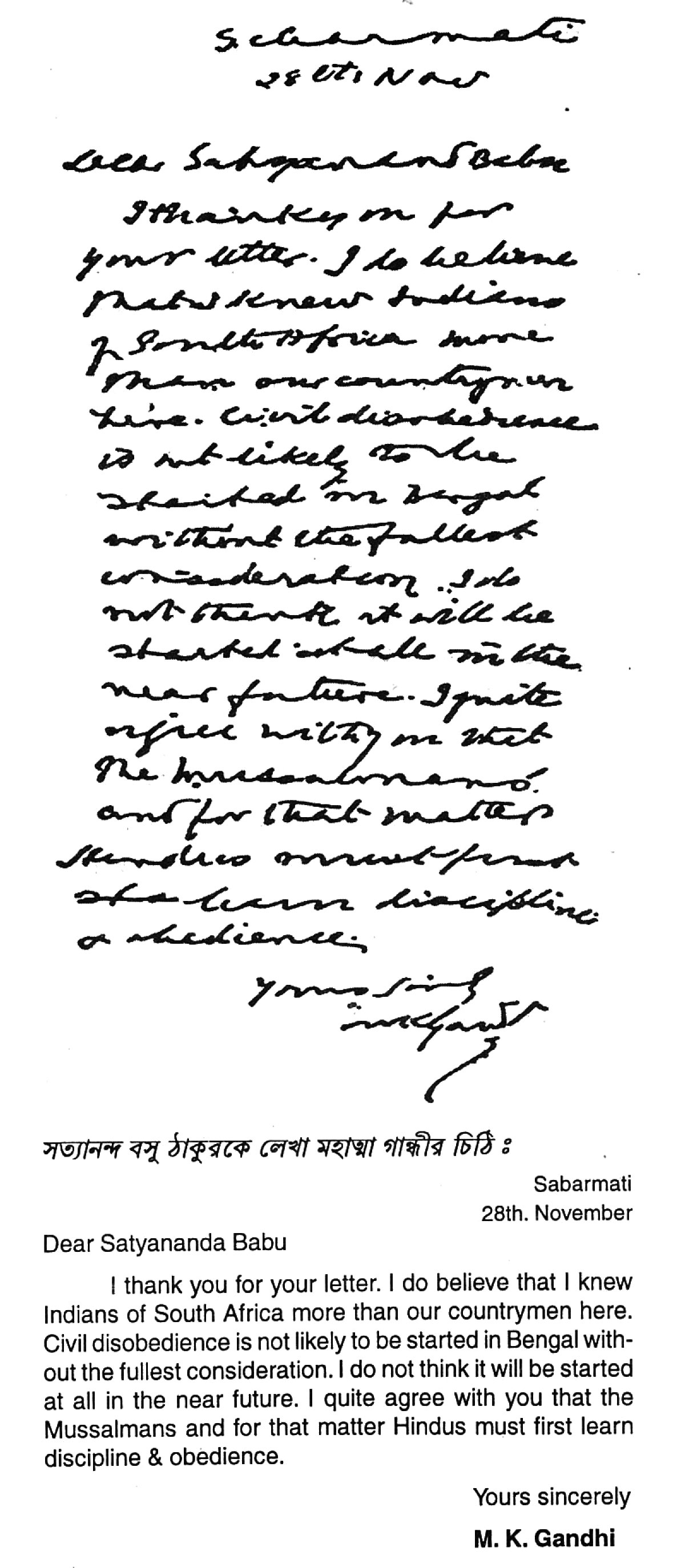
Sri Satyananda Basu Thakur was the only son of Sri Bhagoban Basu Thakur. He was born in Brahminbaria on 22nd October, 1866. He passed his entrance examination mainly from collegiate schools in Faridpur and Krishnanagar. Then he passed his F.A from Presidency College Kolkata in 1883, passed his B.A in 1885 and M.A in 1887. He passed his B.A in Philosophy as First class First and M.A as First Class Second. In 1988 he passed his B.L. But he didn’t like this profession. That is why in 1985 he left the Profession of Law.
He liked to work as a social worker from a very young age. While he was in a school in Krishnanagar he was particularly influenced by a speech by Sri Surendranath Bandhyopadhyay. That is the reason why he joined the nationalist movement by Sri Surendranath while he was in Presidency College. He joined National movements during his student life. At that time people of the country rose up against the British Empire and revolted against them on the issues of Albert Bill, Welcome of Lord Ripon and imprisonment of Sri Surendranath. In 1886 during the 2nd meeting of Bharatiya Jatiyo Congress in Town Hall he worked as a student worker. In 1880 he worked as a volunteer there. From 1904 he completely went into Indian politics.
On 16th October, 1905 the day of partition of Bengal was decided by the British Government. Sri Satyananda Basu was selected by Sri Gopalkrishna Gokhle as the person to be the reporter of National Congress to follow the Bengal Revolution.
In the year 1910 Sri Satyananda Basu was selected the editor of ‘Bongiyo Pradeshik Congress Committee’ at the 25th National Congress conference in Allahabad. He was also selected the member of National Congress in the years 1912 and 1913 at the National Congress conference.
In the year 1915, Gandhiji returned home from South Africa. In the year 1916 he visited Kolkata and met Sri Satyananda Basu at his residence in Dharmatala. Gandhiji presented him with a pair of his own handmade slippers which made this interview a memorable one. Unfortunately, the slipper was not returned when it recently went to an exhibition at the Birla Art Academy. In a letter from Gandhiji it came to be known that how much he respected the political views of Sri Satyananda Basu. A photocopy of this letter is also published hereunder.
Sri Taraknath Palit established the ‘Bengal Technical Institute’ in 1906. Sri Satyananda Basu along with Dr. Nilratan Sarkar was the editor of that college.
He was the member of ‘Jatiyo Bhandar’ which was established by Sri Surendranath Bandhyopadhyay after he returned from jail. He was a lifetime secretary of ‘Jatiyo Bhandar’ established at the house of Sri Poshupati Basu in the year 1906 and also ‘Albert Institute’ which was established by Sri Kesab Chandra Sen. He was also a dedicated member of ‘Ayurbigyan Parishad’. He was also the treasurer of ‘Aikyo Bhandar’ which was created by Sri Swaroop Anandamohan Basu as a protest against division of Bengal and also a treasurer of Jadavpur TB hospital.
He was a part of different developmental institute and other institute. He was a member of number of places like ‘Nimnasranir lok r Unnatitor Samaj’, ‘Samajik Kaaj r League’, ‘Bharatiya Baidhyosastropit’, ‘Bharat Sevashram’, ‘Rammohan Library’, ‘Bharatiya Sangha’, ‘Medical Aid’, ‘Research Society’ and ‘Ballygunge Balika Bidyalaya Committee’. He was also a member of the board of directors at ‘Nari Siksha Samity’, ‘Biswabharati’ and ‘Kolkata Medical School’. He was also a worker at ‘Probortok Sangha’ in Chandannagar. He was never a religious fundamentalist. He was on one hand a member of ‘Albert Institute’ which was a part of Brahmo Samaj and on the other hand he was also a member of ‘Bharat Sevashram’ of the Hindus.
He created ‘Bengal Chemical and Pharmaceutical Works’ jointly with Sri Acharya Prafulla Chandra Roy and was also a director of the same for two years.
He married the eldest daughter of Sri Dwarkanath Raychowdhury (Zamindar of Santosh) and Smt Bindubasini Chowdhury. He had two sons and a daughter.
Sri Satyananda Basu was never really a self-publicized person. He always used to give hand to any social development programs. This was what he was. He was a witness to Indian Independence. He witnessed the condition of this country first hand, though he was not in a condition to protest the things that were prevailing at that moment in the country. He was a silent spectator of all the things that were happening at that time in the country because of his old age and his health. He died in his Nandi Street Residence at the age of eighty two in 8th of July, 1948. On that day his many friends, fans and well-wishers were present at the Kaoratola Crematorium and gave their last respect to him. His relatives were also there to see through his last rites. Even the leading Bengali and English dailies published stories about his life, his works and the sweetness of his character. They also published obituaries and praised him as a great human being.
LETTER WRITTEN BY MAHATMA GANDHI TO SATYANANDA BASU THAKUR :
Sabarmati,
28th November
Dear Satyananda Babu,
I thank you for your letter. I do believe that I know Indians of South Africa more than our countrymen here. Civil Disobedience is not likely to be started in Bengal without the fullest consideration. I do not think it will be started at all in the near future. I quite agree with you that the Mussalmans and for that matter Hindus must first learn discipline and obedience.
Yours Sincerely,
M.K. Gandhi

